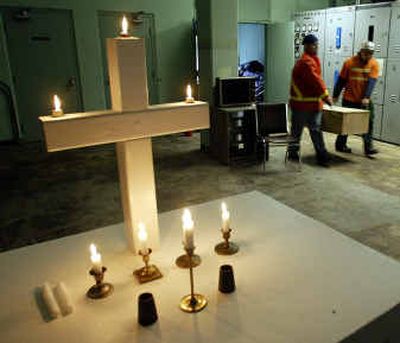Klallam Indians care for ancestor’s disturbed remains

PORT ANGELES, Wash. – Generations of Klallam Indians for years have been told of an ancestral village where their people danced in longhouses and fished off the coast of the Olympic Peninsula.
What they hadn’t known was that their ancestors’ remains lay in scattered pieces, devastated by decades of industrial development, discovered only recently during the state’s project to replace the aging Hood Canal floating bridge.
As state officials face the difficult and expensive task of finding a new site to build the bridge pontoons and anchors, a young generation of Klallam is left to care for hundreds of remains already unearthed and lay to rest the disturbed spirits of their ancestors.
State archaeologists have said the site is the largest archaeological find in the region – the result of a bittersweet and sometimes painful process.
“There’s a lot of good coming out of this. It just shouldn’t have happened this way,” said 23-year-old Carmen Charles, a member of the Lower Elwha Klallam Tribe who has worked at the site since a month after a state employee found the first human bone fragment in August 2003.
Hundreds of Klallam have since visited the 22.5-acre waterfront site, offering blessings and performing cleansing ceremonies to ease the restive spirits of their forebears.
The Klallam, like other American Indians, believe disturbing sacred grounds displeases the spirits, which can lead to injury, or even death, among the living.
To protect themselves and their families, they swipe rusty-red ochre on their cheeks before entering the grounds. When they leave, they wash their hands, arms and faces in bitingly cold snowberry tea.
Working alongside state archaeologists, members between the ages of 17 and 62 have spent the past 16 months delicately scraping away layers of dirt and mud, uneasy and unsure what to expect.
Some finds offer a welcome glimpse into the lives of a people who lived centuries ago at the village Tze-whit-zen (pronounced cha-WHEET-zen, meaning “inside the harbor”), portions of which date back more than 1,700 years. A sawmill was built in the village’s place in the 1920s.
Archaeologists have uncovered shell midden, areas where the Klallam disposed of their food. They’ve found the crumbling cedar walls of six longhouses – at least 50 feet to 100 feet long – and a ceremonial house with a “spitting rock” still in place.
Excavation has also yielded ivory and Chinese coins that the tribe believes were used for trade by travelers who stopped at this harbor inlet.
“We’re grateful for the artifacts and the chance to educate our youth,” said Frances G. Charles, tribal chairwoman. But with each discovery, it gets harder, she said, especially as hundreds of full or partial human skeletons – sometimes small children – are pulled from the ground.
“That’s when you could really feel the cries of our people,” said Charles, who in December asked the state to stop construction at the dry-dock site, although it had already spent $58 million on a project initially slated to cost $283 million. The state agreed and is looking for a new location.
As part of an earlier agreement, the state agreed to pay the tribe $3 million to buy land for a new cemetery and cover additional costs related to reburial. Charles said a site has yet to be chosen.
The state Transportation Department owns the site, and officials want to meet with the tribe to decide how it will be used. Talks are on hold, however, as both sides use the holidays to take a break from the issue.
“It’s been an intense period of time for all of us, especially the tribe,” said Linda Mullen, a spokeswoman for the department.
For now, the tribe has no plans to continue excavation, preferring instead to leave the burial site that already has been so devastated.
The state chose the site to widen and improve the Hood Canal Bridge because other sites were too small or presented permit and hazardous waste issues. The bridge is a major link between the Olympic Peninsula and the Puget Sound region.
Both tribe and state were aware of the former village, but archaeological reviews determined it was south and east of the location where they planned the dry-dock. The tribe also asked that the site be monitored.
No one anticipated the discovery of so many remains, including crushed skulls and other body parts that surrounded metal and concrete water pipes. Pilings used to support a sawmill built in the 1920s had been driven through some skeletons, splitting them in two.
It has brought much heartache on “the Strong People.”
Wearing a blue-and-white bandanna under a dingy white hardhat, Darryl Barkley struggles to describe how he feels knowing his ancestors’ remains were used as backfill.
With a quivering voice and his arms raised in a cradling gesture, he recalled lifting skeletal remains from the ground for the first time. “There’s a lot of power in them bones,” he whispered.
Excavation has uncovered 800 isolated skeletal parts and other artifacts. Members have filled nearly 300 makeshift coffins made of cedar planks and wooden pegs, with crosses cut into the lids.
Some contain the fragile remains of as many as 11 people. Each has been wrapped and will be reburied in a white blanket to keep them warm.
Lonnie Charles and Mike Watson volunteer to take the cedar boxes to a nearby storage building, where candles are lighted almost daily to ensure the spirits remain calm.
Both men said they volunteered for the task, and they don’t wish to give it up.
“I guess I feel protective,” said Watson. “It’s out of respect.”